Christmas during wartime 1940s was bleak especially when Japan entered as National security and economic precautions came into force. Still, there were many eager volunteers to make sure that Christmas was cheery for all, even the Australians fighting overseas.
Preparations for Christmas 1940 started early, as volunteers packed parcels bound for overseas troops.
Over 800 people attended a pantomime “A Year in the Navy” at the Horsham Town Hall.
The Australian Women’s Weekly issue of December 21, 1940 featured a fancy Christmas dinner menu.

Noradjuha school children received a treat with a visit from Father Christmas after their Christmas concert performance.
The message of “Peace on Earth” returned to the newspapers.



WW2 saw the return of Christmas hampers and in August 1941 volunteers were again donating goods, baking puddings or packing. Simple items were in the hampers but a soldier in the trenches would have been grateful for a tin of fruit salad on Christmas day.
Miss Harrison’s shop in Camperdown displayed hampers packed ready for dispatch.
An initiative of the State branch of the Returned Soldiers League saw Horsham children that had fathers fighting overseas, receive a Christmas party in 1941. A nice touch was that each father received a letter to tell them of their children’s treat.
The Federal Treasure urged employers to give their staff War savings certificates or stamps for Christmas 1941 to support the war effort.
The Williamstown Chronicle of December 19, 1941 said “Merry Christmas” to one and all.

Parents had to choose between peaceful toys and war toys in 1941. Tanks, submarines and planes increased in number on the toy shop shelves and hats, balls and drums carried patriotic logos.


Toyland is Divided Over War and Peace. (1941, December 19). Williamstown Chronicle (Vic. : 1856 – 1954), p. 2 Supplement: Greetings Our Christmas Supplement. Retrieved December 18, 2012, from http://nla.gov.au/nla.news-article70713661
Mother always considers Dad’s interests when buying a gift, such as golf clubs or fishing rods, but does Dad think that she may also like a hobby. Don’t blow the budget though!

GIVE MOTHER A GIFT THAT WILL AID HER HOBBY. (1941, December 19). Williamstown Chronicle (Vic. : 1856 – 1954), p. 2 Supplement: Greetings Our Christmas Supplement. Retrieved December 18, 2012, from http://nla.gov.au/nla.news-article70713714
Wartime saw a raft of new regulations imposed on citizens and Christmas was not exempt.
Jack Watts of Horsham, stationed in Malaya over Christmas 1941 wrote home of his Christmas experience. The nurses of the AIF held an entertaining cocktail party.
The work of the Red Cross was often reported on during the 1940s. On this occasion, they were sending 72,000 Christmas boxes to British prisoners across Europe.
Private T.M. Holmes of Gorae had a welcome break from stew and rice for Christmas 1941, spent in the Middle East. A dinner of ham, turkey and plum duff was served by officers while the rank and file gave orders.
Les Hutchins spent Christmas in a hospital in Palestine and was grateful for his Red Cross parcel and the work of the nursing sisters to make sure Christmas for the patients was as happy as possible.

Christmas 1942, and attention had moved from Europe and the Middle East to closer to home. Troops were in New Guinea and family could send mail until November 15
New restrictions were in place during 1942 and again Christmas was under the spotlight. Santa was given the year off.
Printers kept a keen eye out for Christmas terms on their print jobs out of fear of a £100 fine and/or six months imprisonment.
Advertisements were strictly censored as were motion pictures, signs, leaflets, hoardings and more.
Traders were not allowed to employ staff specifically for Christmas trade but boys and girls could be used to free up the adult workforce for war related work.
Many would have been thankful for the double Christmas tea issue of 1942.
If Australian residents did not know what austerity was before WW2, they sure did by the end. The country tightened its belt. Not only that, a shortage of toys, sweets and books limited shopping. Shoppers opted for practical gifts, ties and handkerchiefs.
Private Alfred Mitchell, formerly of Horsham, wrote a letter of thanks to Mr Crouch of Murtoa for the hamper he donated for Christmas 1942. Alf. received goodies including a tin of cream, dried fruit cake, tooth paste, chocolate, tobacco and kool mints.
As was the norm, Alf and the other members of his unit gave their puddings to the cooks to heat.
At the Horsham Methodist Church during December 1943, the congregation enjoyed the story of the nativity, prayers for the King, Prime Minister and Winston Churchill and hymns. The evening finished with a solo of “O Holy Night” by Mrs Wallace. Christmas lilies, white gladioli, ivy and cyprus decorated the church.
Similar evenings were held at the St John’s Church of England and St Andrew’s Presbyterian church, also in Horsham.
The Australian Comforts Fund packed over 400,000 hampers for New Guinea and beyond during Christmas 1943.
Christmas 1944 saw a promise of better toys. Limited materials and labour had reduced the quality during the war period.


Christmas Toys may Improve. (1944, August 25). The Argus (Melbourne, Vic. : 1848 – 1956), p. 8. Retrieved December 19, 2012, from http://nla.gov.au/nla.news-article11358186
Portland people were getting behind the Lord Mayor’s appeal to send toys to Britain for Christmas 1944.
Cecile Besnard of Olinda won first prize in the 1944 Argus plum pudding recipe contest with a Creole Coffee pudding

Despite the Japanese surrender, Christmas hampers were still in great demand for Christmas 1945.
Children that could not remember a Christmas before the war looked forward to celebrating a “real” Christmas in 1945. Santa was back and made in-store appearances. Sadly the toys were still inferior and the dolls thought ugly enough to scare little girls.

Gift suggestion articles were back as retailers got back into the swing of Christmas trading. Dad could expect a brush, socks or even a wool dressing gown worth 44/6 and 8 coupons. If mum was a smoker, maybe a lipstick shaped lighter or for something different, why not a shower curtain?
Gas was in short supply in 1945 as was poultry and ham. On the bright side dried fruits, almonds and holly sprigs were back.
After years of penny-pinching and low-key Christmas days, shoppers were out in force in 1945.

Toys were plentiful, but English mechanical toys were in limited supply and beach toys were unobtainable.
Carols By candlelight was growing in popularity, so the Horsham City Council decided to introduce their own for Christmas 1946. May Park was the proposed venue.
Christmas was brighter in Australia, but in Britain the situation was still grim. Gifts of food could be left at the Camperdown branch of the Red Cross in Manifold Street.

Was this the beginning of what used to be almost annual event? Brewery workers went on strike just before Christmas 1947.
The Red Cross provided transport for patients at the Heidelberg Repatriation Hospital to return home for Christmas 1947. Trucks, cars and ambulances drove patients to towns such as Dunkeld, Port Fairy, Colac and Terang.
The Australian Women’s Weekly had personal gift giving ideas and a new cook book offer in their December 4, 1948 issue.
Father Christmas arrived on a bike for the Portland Kindergarten play-group Christmas party.
Radio 3HA ran a hospital appeal on Christmas day 1948 and due to its success, repeated it in 1949.
December. What a month!

The December 17, 1949 issue of the Australian Women’s Weekly had recipes for Almond Snowballs and Chocolate date log and Christmas table presentation ideas.
The Argus also had Christmas table hints and a recipe for Rabbit pâté.
Horsham traders were not experiencing a Christmas rush in 1949 and cooler weather had slowed the sale of summer clothing. Barnetts, however, saw a rush on that ever popular Christmas gift, handkerchiefs. Men’s dressing gowns were also selling well.
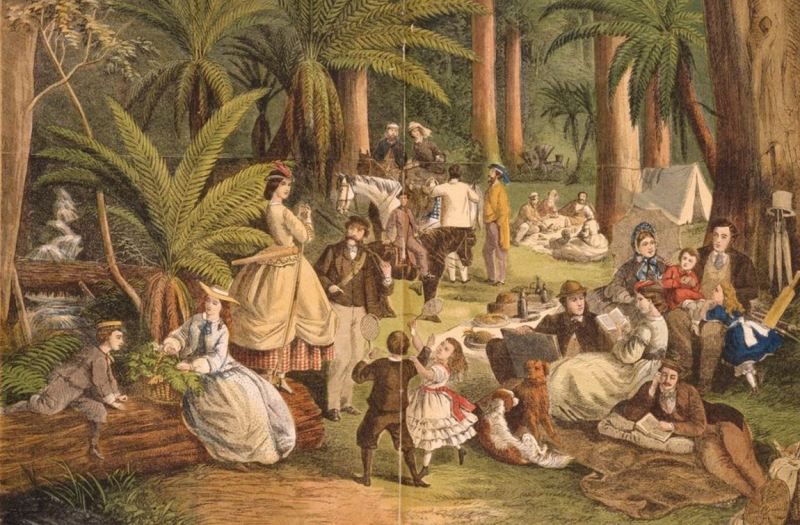
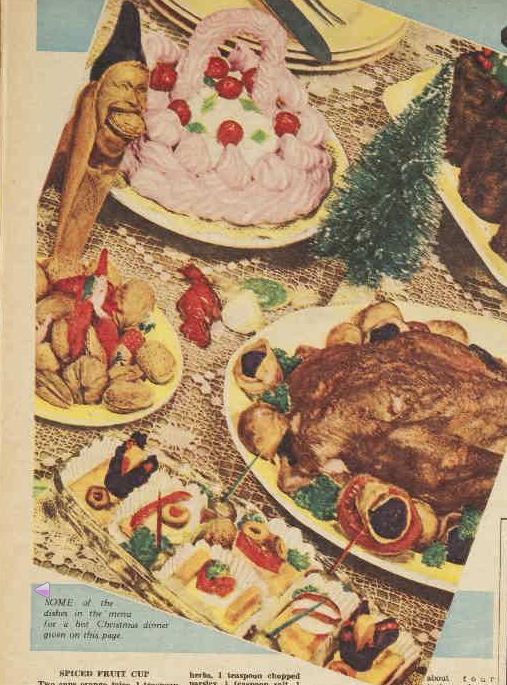
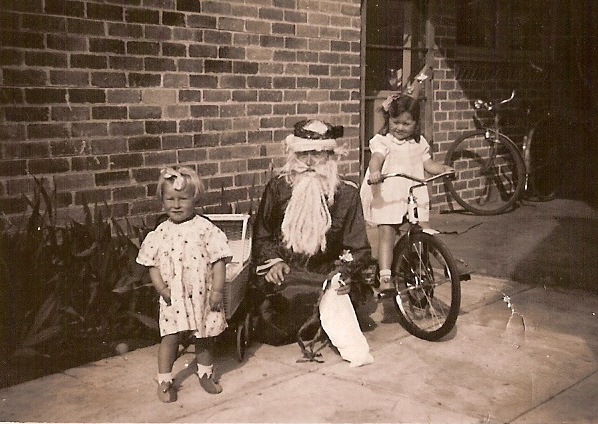














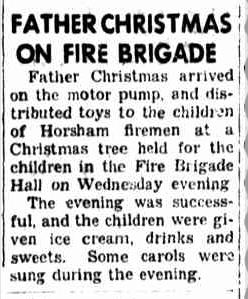















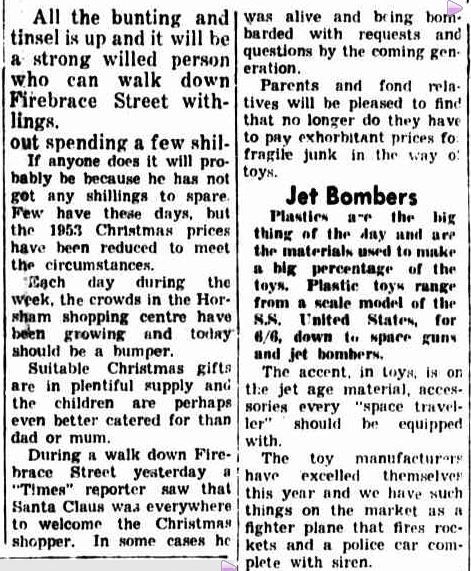








































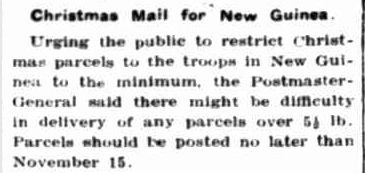



































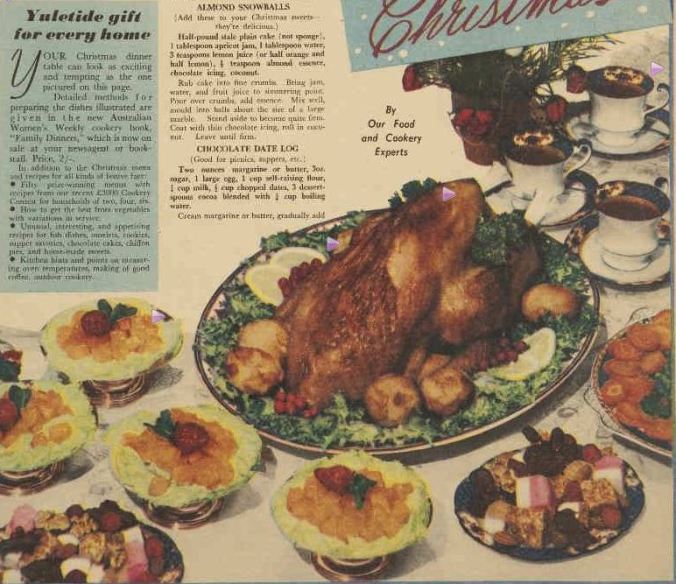



















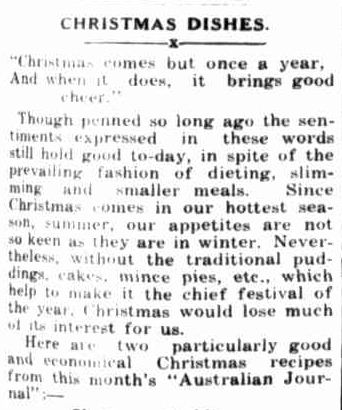























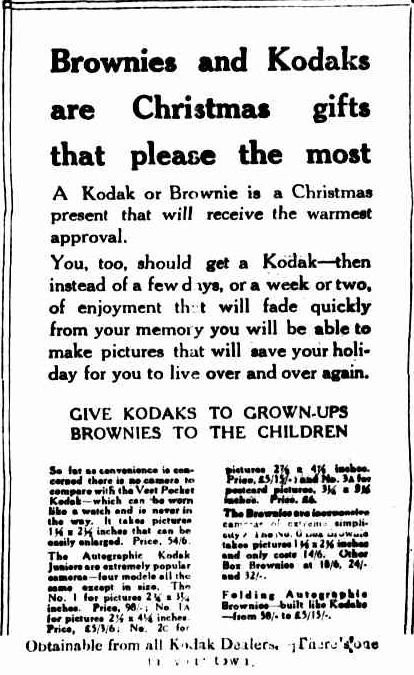
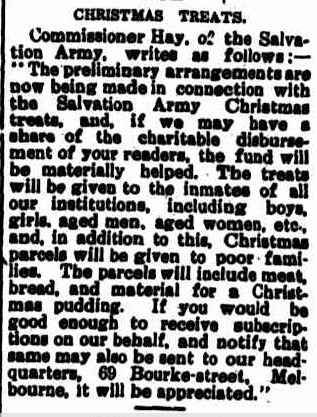













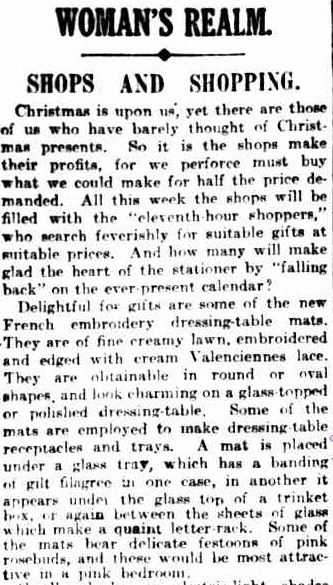












































































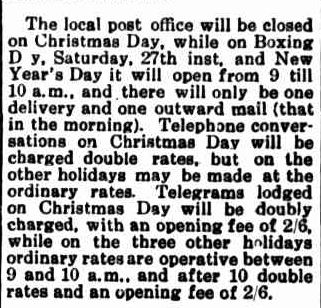































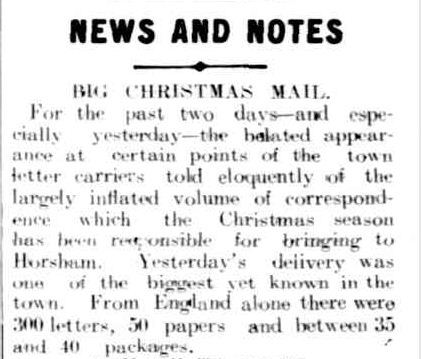
















You must be logged in to post a comment.